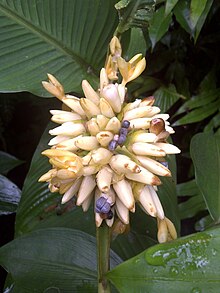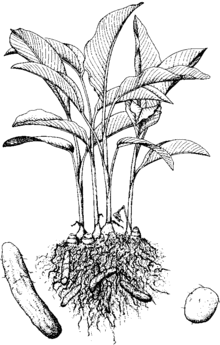| Lerén | |
|---|---|

| |
| Scientific classification | |
| Kingdom: | Plantae |
| Clade: | Tracheophytes |
| Clade: | Angiosperms |
| Clade: | Monocots |
| Clade: | Commelinids |
| Order: | Zingiberales |
| Family: | Marantaceae |
| Genus: | Goeppertia |
| Species: | G. allouia |
| Binomial name | |
| Goeppertia allouia Lindl. | |
| Synonyms | |
| |
Goeppertia allouia (syn. Calathea allouia), known as lerén or lairén in Spanish, and also known in English as Guinea arrowroot, and sweet corn root, is a plant in the arrowroot family, native to northern South America and the Caribbean. The name "allouia" is derived from the Carib name for the plant. Lerén is a minor food crop in the American tropics, but was one of the earliest plants domesticated by pre-historic Amerindians in South America.
Distribution
Goeppertia allouia is native to Cuba, Hispaniola, Puerto Rico, the Lesser Antilles, Trinidad and Tobago, Venezuela, Colombia, Ecuador, Peru and Brazil. It is reportedly naturalized in Jamaica.
Lerén has been introduced as a minor root crop in tropical regions around the world.
Description

Lerén is a perennial plant, approximately 1 metre (39 in) in height. It produces egg-shaped tuberous roots 2 centimetres (0.79 in) to 8 centimetres (3.1 in) long at the end of fibrous roots. The leaves are large, up to 60 centimetres (24 in) long and 20 centimetres (7.9 in) wide. Indigenous people of the Americas have used the durable leaves to make traditional medicines and as baby clothing. Lerén usually reproduces itself through rhizomes which produce shoots and new plants.
Cultivation
Lerén is adapted to a tropical climate with alternating rainy and dry seasons. It sprouts with the first rains and grows rapidly, forming tubers which are harvested as the foliage begins to die back eight or nine months after the initial sprouting. The rhizomes, harvested at the same time, are tolerant of both drying and flooding, and divided and replanted again at the onset of the rainy season. Frequent irrigation is necessary during dry periods. Lerén is often planted in shade or partial shade but can grow in full sun with adequate moisture and nutrients.
Lerén is traditionally cultivated on a small scale. Its cultivation is declining as it has been replaced by other crops.
Food

Lerén is usually cooked by boiling the tubers for 15 to 60 minutes, As food, lerén is often compared to water chestnut (Eleocharis dulcis) because lerén, like the water chestnut, retains its crispness despite being cooked. Boiled lerén has a taste similar to sweet corn, hence one of its common English names. The cooked tuber is covered with a thin, edible skin which is most easily peeled after cooking. Lerén is mostly eaten as an hors d'oeuvre or appetizer. Lerén tubers can be stored at room temperatures for up to three months, but do not tolerate refrigeration well.
The nutritional value of lerén has not been thoroughly studied, but the tubers have a starch content of 13-15 percent and a protein content of 6.6 percent.
Prehistoric domestication
Archaeologists have discovered that lerén was one of the first plants domesticated in prehistoric South America. Lerén, along with arrowroot (Maranta arundinacea), squash (Cucurbita moschata), and bottle gourd (Lagenaria siceraria) were being eaten and possibly cultivated in Colombia by about 9000 BCE. It appears that the cultivation of lerén spread to places where it was not likely native. For example, the people of the Las Vegas culture on the arid and semi-arid Santa Elena Peninsula of Ecuador likely grew lerén by about 9000 BCE. Lerén was being grown to be eaten raw, dried, or ground into flour.
References
- "The Plant List: A Working List of All Plant Species".
- "Topi Tambo, Leren, Guinea Arrowroot", Eat the Weeds, , accessed 17 Feb 2016
- Kew World Checklist of Selected Plant Families, Calathea allouia
- Lindley, John. 1829. Botanical Register 14: sub pl. 1210, Calathea allouia
- Aublet, Jean Baptiste Christophe Fusée. 1775. Histoire des Plantes de la Guiane Françoise 1: 3–4, Maranta allouia
- Forzza, R. C. 2010. Lista de espécies Flora do Brasil "Archived copy". Archived from the original on 2015-09-06. Retrieved 2015-08-20.
{{cite web}}: CS1 maint: archived copy as title (link). Jardim Botânico do Rio de Janeiro, Rio de Janeiro - Hokche, O., P. E. Berry & O. Huber. (eds.) 2008. Nuevo Catálogo de la Flora Vascular de Venezuela 1–860. Fundación Instituto Botánico de Venezuela, Caracas
- Dodson, C.H., A.H. Gentry & F.M. Valverde Badillo. 1985. La Flora de Jauneche: Los Ríos, Ecuador 1–512. Banco Central del Ecuador, Quito.
- Martin, F.W. & Cabanillas, E. (1976) Leren (Calathea allouia), a little known tuberous root crop of the Caribbean. Economic Botany 30(3):249-256. Downloaded from JSTOR.
- FAO, "Guinea Arrowroot" (1994), Neglected Crops: 1492 from a Different Perspective, Plant Production and Protection Series, No. 26, p. 240
- FAO, p. 240
- Martin and Cabanillas, pp. 252-252
- FAO, p. 239
- Martin and Cabanillas, pp. 254-256
- Martin and Cabanillas, p. 254
- Piperno, Dolores R. (Oct 2011), "The Origins of Plant Cultivation and Domestication in the New World Tropics", Current Anthropology, Vol 52, No. 54, pp. S 458-459. Downloaded from JSTOR.
- Moore, Jerry D. (2014), A Prehistory of South America, Boulder: University Press of Colorado, pp. 97-99. Downloaded from Project MUSE.
- Piperno, S-458-459
| Taxon identifiers | |
|---|---|
| Goeppertia allouia | |
| Calathea allouia | |
| Maranta allouia | |
- Goeppertia
- Root vegetables
- Edible plants
- Plants described in 1829
- Flora of Cuba
- Flora of Haiti
- Flora of the Dominican Republic
- Flora of Puerto Rico
- Flora of the Windward Islands
- Flora of the Leeward Islands
- Flora of Trinidad and Tobago
- Flora of Venezuela
- Flora of Colombia
- Flora of Ecuador
- Flora of Peru
- Flora of Brazil
- Plants used in Native American cuisine
- Early agriculture in Mesoamerica
- Tropical agriculture
- Mesoamerican cuisine
- Native American cuisine
- Crops originating from South America